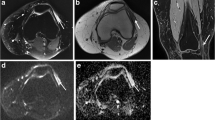Abstract
The purpose of this study was to assess whether gadolinium-enhanced magnetic resonance imaging (MRI) provides diagnostic information beyond that given by nonenhanced imaging in the evaluation of musculoskeletal infectious processes and whether it can be used for differentiating infectious from noninfectious inflammatory lesions. Magnetic resonance images performed with and without intravenous gadolinium-DTPA in 34 cases in which musculoskeletal infection had been clinically suspected were reviewed. Infectious lesionsincluding osteomyelitis, pyarthrosis, abscess, and cellulitis-were confirmed in a total of 22 cases: in 15 by biopsy or drainage and in 7 by clinical course. Our results show that gadolinium-DTPA-enhanced MRI is a highly sensitive technique in diagnosing musculoskeletal infectious lesions. It is especially useful in distinguishing abscesses from surrounding cellulitis/myositis. Lack of contrast enhancement rules out infection with a high degree of certainty. However, contrast enhancement cannot be used to reliably distinguish infectious from noninfectious inflammatory conditions.
Similar content being viewed by others
References
Modic MT, Pflanze W, Feiglin DHI, et al. Magnetic resonance imaging of musculoskeletal infections. Radiol Clin North Am 1986; 24:247.
Herfkens R, Davis P, Crooks L. Nuclear magnetic resonance imaging of the abnormal live rat and correlations with tissue characteristics. Radiology 1981; 141:211.
Beltran J, Chandnani V, McGhee RA, et al. Gadopentetate-dimeglumine-enhanced MR imaging of the musculoskeletal system. AJR 1991; 156:457.
Morrison WB, Schweitzer ME, Bock GW, et al. Diagnosis of osteomyelitis: utility of fat-suppressed contrast-enhanced MR imaging. Radiology 1993; 189:251.
Paajanen H, Brasch RC, Schmiedl U, et al. Magnetic resonance imaging of local soft tissue inflammation using gadolinium-DTPA. Acta Radiol 1987; 28:79.
Paajanen H, Grodd W, Revel D, et al. Gadolinium-DTPA enhanced MR imaging of intramuscular abscesses. Magn Reson Imaging 1987; 5:109.
Gupta NC, Prezio JA. Radionuclide imaging in osteomyelitis. Semin Nucl Med 1988; 18:287.
Robbins SL, Cotran RS, Kumar V. Pathologic basis of disease, 3rd edn. Philadelphia: Saunders, 1984.
Beltran J, Campanini DS, Knight C, McCalla M. The diabetic foot: magnetic resonance imaging evaluation. Skeletal Radiol 1990; 19:37–41.
Moore TE, Yuh WTC, Kathol MH, El-Khoury GY, Corson JD. Abnormalities of the foot in patients with diabetes mellitus: findings on MR imaging. AJR 1991; 157:813–816.
Yuh WTC, Corson JD, Baraniewski HM, et al. Osteomyelitis of the foot in diabetic patients: evaluation with plain film, 99mTc-MDP bone scintigraphy, and MR imaging. AJR 1989; 152:795–800.
Author information
Authors and Affiliations
Rights and permissions
About this article
Cite this article
Hopkins, K.L., Li, K.C.P. & Bergman, G. Gadolinium-DTPA-enhanced magnetic resonance imaging of musculoskeletal infectious processes. Skeletal Radiol. 24, 325–330 (1995). https://doi.org/10.1007/BF00197059
Issue Date:
DOI: https://doi.org/10.1007/BF00197059




